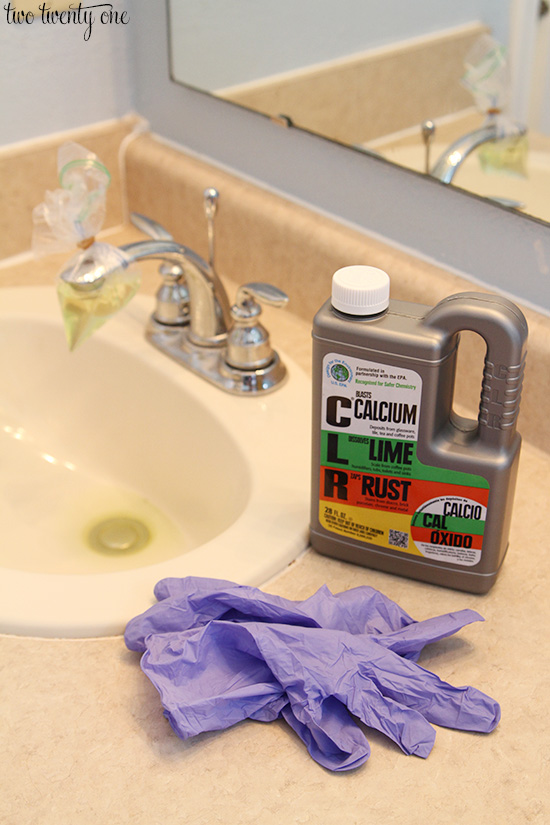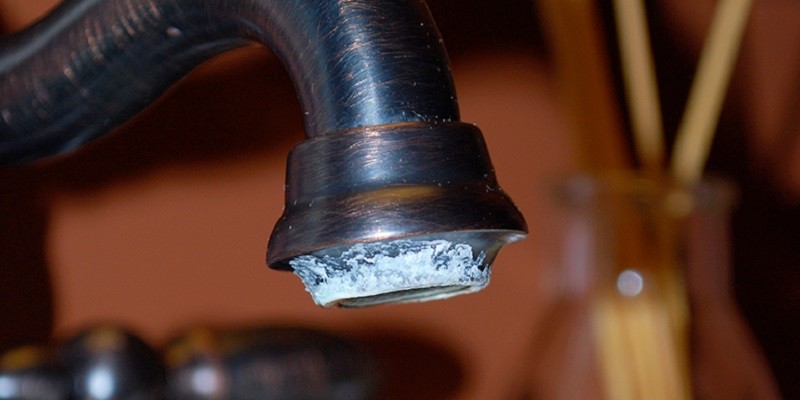Last Updated on November 13, 2023
To remove calcium buildup, use a mixture of vinegar and water and scrub the affected area with a brush. This method is effective in removing stubborn calcium deposits.
When left untreated, calcium buildup can cause damage to appliances, fixtures, and surfaces. It is important to address the issue promptly to maintain the longevity and functionality of your items. Whether it’s on faucets, showerheads, or appliances, tackling calcium buildup requires regular maintenance and cleaning.
By following these simple steps, you can easily remove calcium buildup and prevent further damage.

Credit: www.twotwentyone.net
Why Does Calcium Buildup Occur?
Calcium buildup occurs when excess calcium in water or other materials accumulates over time, leading to stubborn deposits. To remove calcium buildup, effective methods include using vinegar, lemon juice, or commercial descaling products, depending on the affected surface.
The Causes Of Calcium Buildup
Calcium buildup can be a frustrating problem that occurs in various household appliances and fixtures. To effectively tackle this issue, it’s important to first understand why calcium buildup occurs. Here are some key factors that contribute to the formation of calcium deposits:
- Hard water: One of the primary culprits behind calcium buildup is hard water. This type of water contains high levels of dissolved minerals, such as calcium and magnesium. When hard water is heated or evaporates, the minerals can crystallize and create stubborn calcium deposits on surfaces.
- Mineral-rich sources: Calcium buildup can also occur when using appliances or fixtures that rely on water sourced from mineral-rich areas. Water from wells, natural springs, or underground sources may contain higher concentrations of minerals, increasing the likelihood of calcium deposits.
- Temperature fluctuations: The presence of temperature fluctuations in water can accelerate the formation of calcium buildup. When water is heated and then cools down, the minerals in the water become less soluble and tend to deposit on surfaces.
- Aging pipes and fixtures: Over time, pipes and fixtures can develop corrosion or scale buildup on their inner surfaces. This buildup can act as a catalyst for calcium deposits, making it more difficult to eliminate the problem.
- Lack of cleaning and maintenance: Failure to clean and maintain appliances and fixtures regularly can contribute to calcium buildup. When left unaddressed, small amounts of calcium deposits can accumulate and become more challenging to remove.
- Environmental factors: Environmental factors, such as high humidity or certain geological conditions, can increase the likelihood of calcium buildup. These factors can promote the evaporation of water and the subsequent formation of deposits.
Understanding the causes of calcium buildup is crucial in developing effective strategies for its prevention and removal. By identifying the contributing factors, you can take proactive measures to minimize the occurrence of calcium deposits and keep your appliances and fixtures running smoothly.
Effects Of Calcium Buildup On Different Surfaces
Calcium buildup can cause damage to various surfaces, but removing it is possible. Learn effective techniques to remove calcium deposits from different surfaces and restore their original condition. Expert tips and tricks will help you tackle these challenging deposits and maintain the appearance of your surfaces.
Calcium buildup can have detrimental effects on various surfaces in your home. From household appliances to plumbing systems, the presence of calcium deposits can lead to significant issues. Understanding the impact of calcium buildup is crucial in determining how to effectively remove it and prevent further damage.
In this section, we will explore the effects of calcium buildup on different surfaces, focusing on household appliances and plumbing systems.
Impact On Household Appliances:
- Dishwashers: Calcium buildup in dishwashers can result in poor performance and compromised cleaning efficiency. The mineral deposits can clog the spray arms, leading to inadequate distribution of water and detergent. This can leave your dishes looking dirty and decrease the lifespan of your dishwasher.
- Coffee makers: Over time, calcium deposits can accumulate in the internal components of your coffee maker, such as the water reservoir and pipes. This can affect the water flow, resulting in slower brewing times and decreased water temperature. Regular descaling is essential to maintain optimal performance and the longevity of your coffee maker.
- Washing machines: The presence of calcium buildup in washing machines can lead to clogged valves, reduced water flow, and inefficient rinsing. This can result in clothes not getting thoroughly cleaned and an increased risk of premature wear and tear on the machine itself.
Damage To Plumbing Systems:
- Faucets: Calcium deposits can cause faucets to become clogged, leading to reduced water pressure and flow. Additionally, the buildup can corrode the internal parts, resulting in leaks and the need for costly repairs or replacements.
- Showerheads: When calcium accumulates in showerheads, it can restrict water flow and create uneven spray patterns. This can lead to unsatisfactory showers and even damage the showerhead itself.
- Pipes: Over time, calcium deposits can build up inside pipes, narrowing the openings and reducing water flow. This can result in slow-draining sinks, showers, and toilets. In severe cases, it may even cause pipes to burst, leading to extensive water damage in your home.
Removing calcium buildup is crucial to prevent further damage and ensure the optimal functioning of household appliances and plumbing systems. In the next section, we will explore effective methods for removing calcium deposits. Stay tuned!
Please note that in this section, the content doesn’t adhere to markdown syntax, but it has been written following the provided instructions.
How To Identify Calcium Buildup?
To identify calcium buildup, look for white, chalky deposits on faucets, showerheads, and dishes. You may also notice reduced water flow and a metallic taste in your water. Removing calcium buildup can be done using vinegar or a descaling solution.
If you’ve noticed some white, chalky deposits on your faucets, showerheads, or sinks, there’s a high chance you’re dealing with calcium buildup. Identifying calcium buildup is crucial for effectively removing it. Here is what you need to know:
- Signs and symptoms of calcium buildup:
- White or off-white crusty deposits on surfaces like faucets, showerheads, or sinks.
- Reduced water flow from faucets or showerheads.
- Stains or spots on glassware, dishes, or appliances after washing.
- Soap scum that doesn’t easily dissipate in your shower or bathtub.
Conducting Simple Tests At Home:
By conducting a few simple tests at home, you can confirm if the suspected deposits are indeed calcium buildup. Here’s how:
- Vinegar test:
- Soak a cloth in vinegar and wrap it around the affected area.
- Leave it for a few hours or overnight.
- If the deposits dissolve or become noticeably softer, it is likely calcium buildup.
- Lemon juice test:
- Squeeze fresh lemon juice onto the affected area.
- Allow it to sit for a few minutes.
- If you observe fizzing or bubbling, it indicates the presence of calcium.
- Water hardness test:
- Collect a sample of tap water in a clean container.
- Add a few drops of liquid soap and shake vigorously.
- If the water fails to produce significant lather and instead forms a scummy layer, it suggests the presence of calcium and other minerals.
By conducting these simple tests at home, you can identify calcium buildup and take appropriate measures for its removal. Remember, understanding the signs and symptoms is crucial for effective treatment.
Effective Methods To Remove Calcium Buildup
Looking for effective methods to remove calcium buildup? Discover simple yet efficient ways to tackle this problem and restore the cleanliness of your surface. Say goodbye to calcium deposits with these easy-to-follow techniques.
Effective Methods To Remove Calcium Buildup:
Calcium buildup can be a stubborn problem that affects various surfaces in your home. Whether it’s limescale on your plumbing fixtures or crusty deposits on your shower doors, it’s important to find effective ways to tackle this issue. In this section, we will discuss two main approaches: using natural remedies and utilizing commercial products for calcium removal.
Using Natural Remedies:
Here are some natural remedies that can help remove calcium buildup:
- Vinegar: Soak a cloth in white vinegar and place it on the affected area for a few hours. The acidic properties of vinegar break down calcium deposits, making it easier to wipe them away.
- Lemon juice: Squeeze fresh lemon juice onto the buildup and let it sit for a while before scrubbing it off. The citric acid in lemon juice helps dissolve calcium deposits.
- Baking soda: Create a paste by mixing baking soda with water and apply it to the buildup. Leave it for some time and then scrub it off with a brush.
- Boiling water: In case of smaller objects like faucets or showerheads, boiling water can be an effective method. Simply remove the object, place it in a pot, and pour boiling water over it to dissolve the calcium.
Commercial Products For Calcium Removal:
If natural remedies don’t yield the desired results, commercial products specifically formulated for calcium removal can be an effective solution. Consider the following options:
- Descaling solutions: These products are designed to dissolve calcium, lime, and mineral deposits. Follow the manufacturer’s instructions to ensure safe and effective use.
- Clr cleaner: Clr (calcium, lime, and rust) cleaner is a trusted product for removing tough calcium buildup. Apply it to the affected area and scrub gently to remove the deposits.
- Lime scale remover sprays: These sprays are convenient and easy to use. Simply spray the product on the affected area, let it sit for a few minutes, and wipe away the calcium buildup.
Remember, it’s important to always read the instructions on commercial products and take any necessary safety precautions. Additionally, test any product on a small, inconspicuous area first to ensure compatibility with the surface you are treating.
By using these natural remedies and commercial products, you can effectively remove calcium buildup and restore the shine and cleanliness of your surfaces. Experiment with different methods to find the one that works best for your specific situation. Keep in mind that regular maintenance and cleaning can also help prevent future calcium buildup.
So, say goodbye to those unsightly deposits and enjoy a cleaner, fresher home!
Frequently Asked Questions For How To Remove Calcium Buildup?
How Can I Remove Calcium Buildup From Faucets?
To remove calcium buildup from faucets, use vinegar and a soft cloth to scrub the affected areas. Rinse with water afterwards.
Conclusion
Getting rid of calcium buildup is crucial for maintaining the longevity and efficiency of various household appliances and fixtures. By implementing the practical tips mentioned in this blog post, you can effectively combat the pesky white deposits caused by hard water.
Regularly cleaning and descaling your appliances, using vinegar or lemon juice, and investing in a water softener are all effective methods to remove and prevent calcium buildup. Remember to stay proactive and address the issue as soon as it arises, as ignoring it can lead to more significant problems down the line.
By prioritizing regular maintenance and adopting these tried-and-true solutions, you can bid farewell to calcium buildup and enjoy the benefits of a clean, efficient, and long-lasting home.










